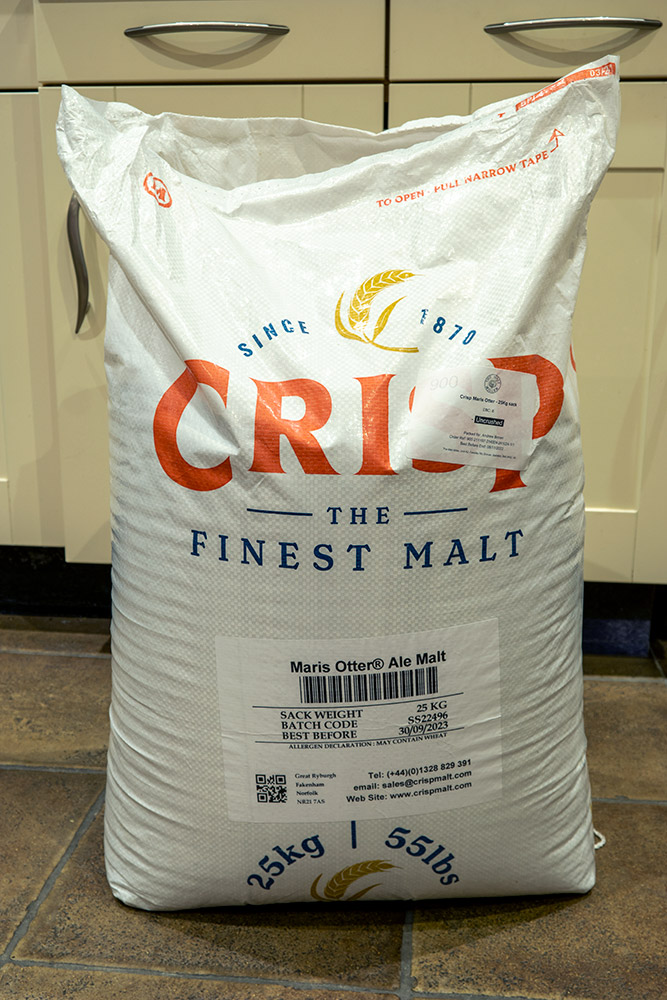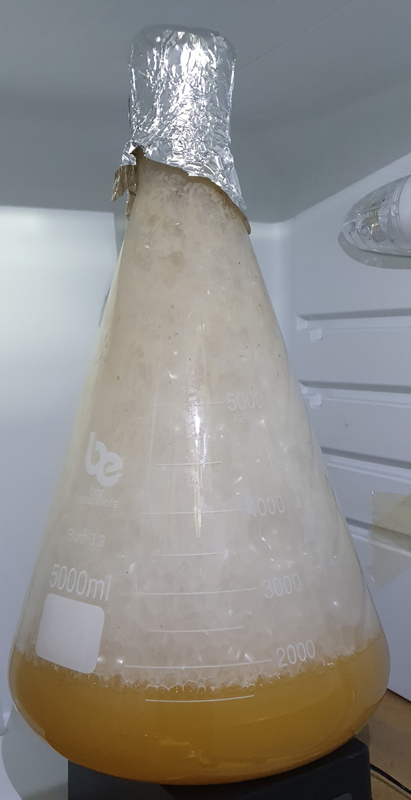You are using an out of date browser. It may not display this or other websites correctly.
You should upgrade or use an alternative browser.
You should upgrade or use an alternative browser.

Help Support The Homebrew Forum:
This site may earn a commission from merchant affiliate
links, including eBay, Amazon, and others.
Here's the recipe for my Dark Ruby Mild. It's almost a direct copy of Graham Wheeler's version but with a few small adjustments. I split the 15% crystal into 10% 150 EBC and 5% 240 EBC to give it a little more complexity and hopefully some rich toffee notes from the 240.
I scaled the recipe up to 24 litres and adjusted the hop weights to maintain Graham's target IBU. I also scaled the grain weight to get an OG that I think will result in an ABV close to the original's 6.0%. Finally, I used Carafa Special II to darken it and add a hint of coffee without the harshness of the black malts.
I wasn't sure about the ideal water profile for a mild so I went with something chloride-heavy to accentuate the malty flavours. The base water for this brew was Tesco Elmhurst. I couldn't use my usual Ashbeck because the mash pH would have dropped far too low. Elmhurst has a nice low mineral level with enough additional alkalinity to allow the use of dark malts.
I was up at 6:00am as is usual for my Sunday brewdays and got started by grinding the grain while the treated mash water was heating up.
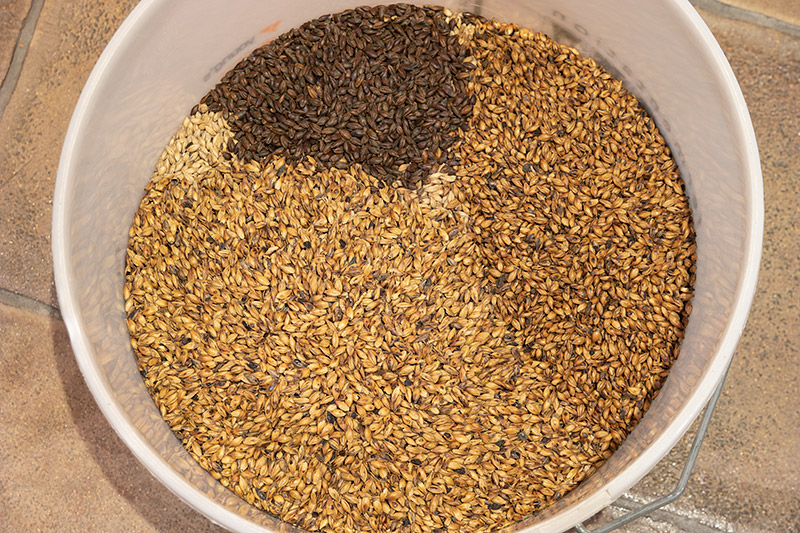
I mashed in at 69C, slightly higher than the 68C that I mashed my Landlord at. I'm still learning how the Brewlab yeast responds to mash temperature and I'm trying to coax a slightly higher FG out of it so that this beer has more perceived body. After all, the original Sarah Hughes is very full flavoured.
What followed was a straightforward brewday with nothing exciting to report except that I forgot to put a memory card in my camera and didn't notice the warning message so the photograph I took of the sample jar didn't get saved. Oh well, I can report that I hit 1.052 vs. the predicted 1.053 which I'm happy with. The wort was a nice nut-brown colour and tasted rich and smooth.
Chilling was very quick thanks to my new Klarstein 12 chiller and the wort was already down to 20C by the time I'd transferred it to the fermenter. The 1 litre starter of Brewlab Yorkshire was pitched at about 1pm and it's all now tucked up in the brew fridge set to 20C.
I scaled the recipe up to 24 litres and adjusted the hop weights to maintain Graham's target IBU. I also scaled the grain weight to get an OG that I think will result in an ABV close to the original's 6.0%. Finally, I used Carafa Special II to darken it and add a hint of coffee without the harshness of the black malts.
I wasn't sure about the ideal water profile for a mild so I went with something chloride-heavy to accentuate the malty flavours. The base water for this brew was Tesco Elmhurst. I couldn't use my usual Ashbeck because the mash pH would have dropped far too low. Elmhurst has a nice low mineral level with enough additional alkalinity to allow the use of dark malts.
Code:
Recipe Specifications
--------------------------
Recipe: Dark Ruby Mild
Date: 12 Dec 2021
Batch Size (fermenter): 24.00 L
Estimated OG: 1.053 SG
Estimated Color: 40.5 EBC
Estimated IBU: 34.3 IBUs
Brewhouse Efficiency: 75.00 %
Est Mash Efficiency: 75.6 %
Boil Time: 60 Minutes
Finished water profile: Ca:188, Mg:14, Na:6, SO4:71, Cl:228
Mash pH: 5.30
Ingredients:
------------
Amt Name Type %/IBU Volume
8.50 g Calcium Chloride (Mash) Water Agent - -
2.80 g Gypsum (Calcium Sulfate) (Mash) Water Agent - -
1.20 ml Lactic Acid (Mash) Water Agent - -
4.504 kg Crisp Maris Otter (7.9 EBC) Grain 83.7 % 2.94 L
0.538 kg Crisp Light Crystal (150.0 EBC) Grain 10.0 % 0.35 L
0.269 kg Crisp Medium Crystal (240.0 EBC) Grain 5.0 % 0.18 L
0.070 kg Weyermann Carafa Special II (1150.0 EBC) Grain 1.3 % 0.05 L
1.70 g Calcium Chloride (Sparge) Water Agent - -
0.60 g Gypsum (Calcium Sulfate) (Sparge) Water Agent - -
31.00 g Fuggle [5.00 %] - Boil 60.0 min Hop 15.0 IBUs -
22.00 g East Kent Goldings (EKG) [6.80 %] - Boil 60.0 mi Hop 15.9 IBUs -
19.00 g Fuggle [5.00 %] - Boil 10.0 min Hop 3.3 IBUs -
1.0 pkg Brewlab Yorkshire Yeast - -
Mash Schedule: Single Infusion, Full Body
Total Grain Weight: 5.381 kg
----------------------------
Name Description Step Temperat Step Time
Mash In Add 25.12 L of water at 76.0 C 69.0 C 60 min
Sparge: Dunk sparge with 5L of 75C water.
I mashed in at 69C, slightly higher than the 68C that I mashed my Landlord at. I'm still learning how the Brewlab yeast responds to mash temperature and I'm trying to coax a slightly higher FG out of it so that this beer has more perceived body. After all, the original Sarah Hughes is very full flavoured.
What followed was a straightforward brewday with nothing exciting to report except that I forgot to put a memory card in my camera and didn't notice the warning message so the photograph I took of the sample jar didn't get saved. Oh well, I can report that I hit 1.052 vs. the predicted 1.053 which I'm happy with. The wort was a nice nut-brown colour and tasted rich and smooth.
Chilling was very quick thanks to my new Klarstein 12 chiller and the wort was already down to 20C by the time I'd transferred it to the fermenter. The 1 litre starter of Brewlab Yorkshire was pitched at about 1pm and it's all now tucked up in the brew fridge set to 20C.
Last edited:
SlackerOh well, I can report that I hit 1.052 vs. the predicted 1.053 which I'm happy with
Interesting to note actually from your Mild recipe @foxbat how relatively dark Crisp's light & medium crystal are compared to others - I'm pretty certain the stuff I get from my LHBS (the crystal malts at least) are Simpsons, and their dark crystal is allegedly ~95L (250EBC) and the extra dark crystal is ~170L (450EBC).
Crisp do seem to label their crystal one level lighter than everyone else, e.g. 240 EBC = medium in Crisp's world. I remember years ago not really looking at the colour and just buying 'medium' which turned out to a happy mistake because that 240 stuff is delicious in a bitter.Interesting to note actually from your Mild recipe @foxbat how relatively dark Crisp's light & medium crystal are compared to others - I'm pretty certain the stuff I get from my LHBS (the crystal malts at least) are Simpsons, and their dark crystal is allegedly ~95L (250EBC) and the extra dark crystal is ~170L (450EBC).
After 14 days in the fermenter I decided to keg the Dark Ruby Mild. Bubbling from the blow-off tube had ceased a couple of days ago so it was definitely time to get it transferred.
I got one corny keg and 3 bottles before the fermenter ran dry. My experiment in trying to raise the mash temperature (69C in this case) to lift the final gravity worked because this one attenuated 82% to finish at 1.009. For comparison the Landlord attenuated 84% and the Simple Autumn Ale 88% for mash temperatures of 68C and 66C, respectively.
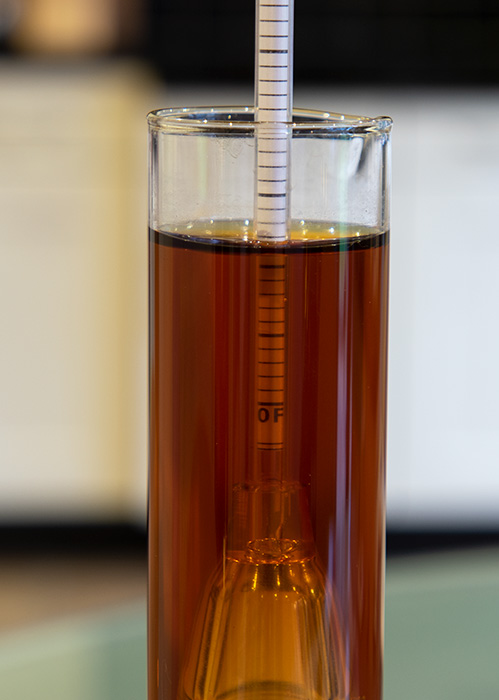
The ABV is 5.7% and although the colour looks quite light here in the jar I think it will look darker in a pint glass once it's ready. I fined the keg with dissolved leaf gelatin, purged the head space with CO2 and it's now carbonating and conditioning at about 10psi.
I think this one will benefit from a longer conditioning time so I don't expect to start it for at least a month.
I got one corny keg and 3 bottles before the fermenter ran dry. My experiment in trying to raise the mash temperature (69C in this case) to lift the final gravity worked because this one attenuated 82% to finish at 1.009. For comparison the Landlord attenuated 84% and the Simple Autumn Ale 88% for mash temperatures of 68C and 66C, respectively.

The ABV is 5.7% and although the colour looks quite light here in the jar I think it will look darker in a pint glass once it's ready. I fined the keg with dissolved leaf gelatin, purged the head space with CO2 and it's now carbonating and conditioning at about 10psi.
I think this one will benefit from a longer conditioning time so I don't expect to start it for at least a month.

£14.76
Digital Temperature Watch Heating Thermometer Home Brewing Tools for Wine Bottle
B&D DIRECT STORE

£13.79
£18.99
New Brewing Lager Beer: The Most Comprehensive Book for Home and Microbrewers
Amazon.co.uk

£437.77
HMCOCOOFM 4L 4" OD119mm * 1.5" OD50.5mm Copper Onion Head For Homebrewing,Thickness 1.5mm (With Thermometer)
weifangguanhuawangluokejiyouxiangongsi

£73.98
Sanitary clamp 2" (51mm) OD64mm Sanitary Tri-Clamp 90-Degree Pipe With Nipple And Electronic Thermometer, Stainless Steel 304 Home brewing(Without Thermometer)
DAN CHENG XIAN PENG SHI DA SHANG MAO DIAN

£5.42 (£0.02 / 100 ml)
Elderflower Sparkling Wine Yeast 5-25L Homebrew Wine, Mead, Cider, Ginger Beer
247 Homebrew

£6.59 (£235.36 / kg)
2X Bulldog Mead Yeast & Nutrient High Alcohol 28g for 20-25L
Virtuoso (VAT Registered)

£23.75 (£25.45 / 75 cl)
Kinsale Mead Co. Atlantic Dry Mead 70cl, Light, Off Dry, Refreshingly Different Award-Winning Honey Mead, 12% ABV
Amazon.co.uk

£53.51 (£11.89 / l)
Mead Liqueur Making Kit - 4.5L High Alcohol Homebrew Liqueurs 20% ABV Moonshine
247 Homebrew

£62.70
Cider Making Kit - with Bottles - 10L/2 Gallon/20 Pints Home Brew Beer Ale Lager
247 Homebrew
How will you condition it @foxbat , warmer, cooler, lower pressure, higher pressure?I think this one will benefit from a longer conditioning time so I don't expect to start it for at least a month.
I know from experience what I'd do with bottled dark beers but I can't get any response, let alone a straight answer, how to approach it with kegs.
I left my Porter on the gas at low pressure for 4 weeks at garage temp before putting it in the kegerator. Even then I've noticed it continue to round off and mellow in the 4 weeks or so since I started drinking it.
Time for an update on my attempt at the GW TTL recipe since I'm on the beer again now January's as good as done  .
.

It's good beer but it's really quite different to the original Taylor's. I now know that they use invert sugar which is why mine is lighter. Mine is stronger because the yeast attenuated so well though that doesn't really come through in the taste. Mine is much drier due to the high level of gypsum I added in this recipe. So apart from the colour, flavour and strength it's identical to the original then
 .
.
Overall I could view this one as a work in progress but I've got so many more bitter recipes to try over the next few months that it will be some time before I decide whether to do this again.

It's good beer but it's really quite different to the original Taylor's. I now know that they use invert sugar which is why mine is lighter. Mine is stronger because the yeast attenuated so well though that doesn't really come through in the taste. Mine is much drier due to the high level of gypsum I added in this recipe. So apart from the colour, flavour and strength it's identical to the original then
Overall I could view this one as a work in progress but I've got so many more bitter recipes to try over the next few months that it will be some time before I decide whether to do this again.
Thought you'd been a bit quiet lately!now January's as good as done
I was thinking it looks quite light, a little bit darker than a pub lager would you say? This is something I found with a recent brew of mine - I know you don't taste the colour itself, and there's a broad spectrum when it comes to bitter but there does seem to be a point where it gets too light and it just doesn't seem right for the style.I now know that they use invert sugar which is why mine is lighter.
And I thought my water had a high mineral content! I just had a look at the water profile you used and nearly fell out of my seat!Mine is much drier due to the high level of gypsum I added in this recipe.
Please do tell! Whereas last year I focused on 3 recipes I've decided 2022 is the year to give bitter some attention. But it's a weird style and the recipes I've looked at aren't radically different from my starting point so it's hard to know what changes to try - this yeast strain or that one, a bit more or less of which colour crystal malt(s), these English hops or those ones (or not an English one at all!). It's somehow a very narrow style and at the same time very broad!Overall I could view this one as a work in progress but I've got so many more bitter recipes to try over the next few months that it will be some time before I decide whether to do this again.
That's about right. The 35g of Carafa Special II didn't add as much colour as I thought it would. 50-60g would probably make the colour right. I was hesitant with the quantity because 70g of Midnight Wheat goes into my Mainline Bitter and that's very dark - much more than TTL should be so I held off a bit.I was thinking it looks quite light, a little bit darker than a pub lager would you say? This is something I found with a recent brew of mine - I know you don't taste the colour itself, and there's a broad spectrum when it comes to bitter but there does seem to be a point where it gets too light and it just doesn't seem right for the style.
I decided to experiment and used Murphy's 400ppm sulphate recommendation. It was really hard to dissolve all that gypsum and although the flavour is fine I don't think all the extra effort with the stick blender is worth it. I'll bring down the sulphate level next time. It's good to experiment. I don't want to be that "always done it this way for 40 years never had a problem" guy.And I thought my water had a high mineral content! I just had a look at the water profile you used and nearly fell out of my seat!
This is a good point. I like a smooth MO malt profile myself and will stick to lower overall mineral levels in future.This is something I've started to work on recently though as I think I've been overdoing it with the gypsum in general - it's called "bitter" so you'd think you'd want a higher SO4:Cl ratio but I'm wondering if more neutral is better so as not to totally lose the malt character. Mind you it's a nice problem to have if you're just worrying about subtle tweaks to the water profile.
Going through my GW book I've lined up the following for this year:Please do tell! Whereas last year I focused on 3 recipes I've decided 2022 is the year to give bitter some attention. But it's a weird style and the recipes I've looked at aren't radically different from my starting point so it's hard to know what changes to try - this yeast strain or that one, a bit more or less of which colour crystal malt(s), these English hops or those ones (or not an English one at all!). It's somehow a very narrow style and at the same time very broad!
Flowers Original
Theakston's Best
Black Sheep Bitter
Black Sheep Ale
Camerons Strongarm
Courage Directors
As you say the recipes are all so similar that they may all end up tasting the same!
Here are pics of my TTL clone (pic with tomato sauce bottle behind) and a pint from a bottle I bought for comparison (no tomato sauce). The recipe I followed asked for a small amount of black malt which I didn't have, thus my pint being slightly lighter. I really enjoyed this brew (I splashed out on liquid yeast for this one - I had great plans to reuse the yeast but that hasn't happenedTime for an update on my attempt at the GW TTL recipe since I'm on the beer again now January's as good as done.

It's good beer but it's really quite different to the original Taylor's. I now know that they use invert sugar which is why mine is lighter. Mine is stronger because the yeast attenuated so well though that doesn't really come through in the taste. Mine is much drier due to the high level of gypsum I added in this recipe. So apart from the colour, flavour and strength it's identical to the original then.
Overall I could view this one as a work in progress but I've got so many more bitter recipes to try over the next few months that it will be some time before I decide whether to do this again.
Attachments
Camerons Strongarm
I made the Cameron Strongarm from the GW book twice about 10 years ago - once extract and once all-grain. They were probably approaching the best two beers I've ever brewed which is even more amazing when it's not usually my favourite beer style. Maybe that just means it's easy for an amateur like me to get right but your post has reminded me to line it up as one of my next ones now that I'm brewing regularly again!
Well that's the thing...As you say the recipes are all so similar that they may all end up tasting the same!
Okay we can play around with the hops, but the ones you might use (traditionally at least) don't really steal the show in the way American hops do, for example...
Which leads me to wonder if the character of a bitter is a lot more yeast driven than we tend to appreciate?
Yours is very similar colour-wise to the original. Mine isn't a million miles off but it does need to be darker.Here are pics of my TTL clone (pic with tomato sauce bottle behind) and a pint from a bottle I bought for comparison (no tomato sauce). The recipe I followed asked for a small amount of black malt which I didn't have, thus my pint being slightly lighter. I really enjoyed this brew (I splashed out on liquid yeast for this one - I had great plans to reuse the yeast but that hasn't happened). I'll definitely make this again, possibly with a higher carbonation, but not sure when. I happened to be in Leeds last weekend and found TTL on handpull, best pint of the night
.
Good to hear that it's a sound recipe. I'll look forward to brewing it.I made the Cameron Strongarm from the GW book twice about 10 years ago - once extract and once all-grain. They were probably approaching the best two beers I've ever brewed which is even more amazing when it's not usually my favourite beer style. Maybe that just means it's easy for an amateur like me to get right but your post has reminded me to line it up as one of my next ones now that I'm brewing regularly again!
Hey @foxbat , while you're talking starters I've been meaning to ask you...
When it comes to lager yeast starters (WY2308 in this case) what temperature do you normally go for?
Do you go room temp 20degC ish or more like the recommended temp for that strain?
My gut tells me the latter - for 2308 Wyeast say 9-13degC so I plan to ferment at the 11degC midpoint and I would have thought the same for the starter???
When it comes to lager yeast starters (WY2308 in this case) what temperature do you normally go for?
Do you go room temp 20degC ish or more like the recommended temp for that strain?
My gut tells me the latter - for 2308 Wyeast say 9-13degC so I plan to ferment at the 11degC midpoint and I would have thought the same for the starter???
20C for them all. The idea is that you're trying to maximise growth rate not make beer. 2308 is a very nice lager yeast: rich and malty like the Wyeast description says.Hey @foxbat , while you're talking starters I've been meaning to ask you...
When it comes to lager yeast starters (WY2308 in this case) what temperature do you normally go for?
Do you go room temp 20degC ish or more like the recommended temp for that strain?
My gut tells me the latter - for 2308 Wyeast say 9-13degC so I plan to ferment at the 11degC midpoint and I would have thought the same for the starter???
I'm going to get some Brupak Antifoam for my next starter. This yeast is crazy. It's fallen back now but not before pushing up the foil and making a mess of the flask neck.
Today's brew is another one from the Graham Wheeler book: Flowers Original. It's a simple, low gravity bitter that should make an easy drinking alternative to the strong dark mild that I've currently got on tap.
The huge krausen on the starter had settled back by Friday morning leaving a bit of a yeasty mess under the foil cap. I decanted off 500ml for next time and left the remainder in-place to chill ready for today.
Here's the recipe.
The 10g addition of Archer hops at 10 minutes is mine. I decided that since I was using the darker crystal 240 then it would help to balance out the flavours. As it turned out I had less of the Styrian Goldings left than I thought and had to substitute some Saaz. So at the end of the day my 10 minute additions turned into 10g Archer, 4g Styrian Goldings and 6g Saaz. I'm sure it'll be fine.
I've come to expect the Brewlab Yorkshire yeast to attenuate really strongly if I mash at the 'usual' 65-67C range so I'm doing what I did with the dark mild and mashing at 69C in an attempt to reign it in a bit.
The dextrose was added during the boil and should serve to lighten the body a bit making this nice and quaffable. In my system 75g of sugar equals 1 extra gravity point so I'm getting about 4 points from the 295g in this recipe.
It was a nice and simple brewday and I was all done with the yeast pitched before midday. The OG was spot on at 1.038 and the colour is a nice and pale copper.
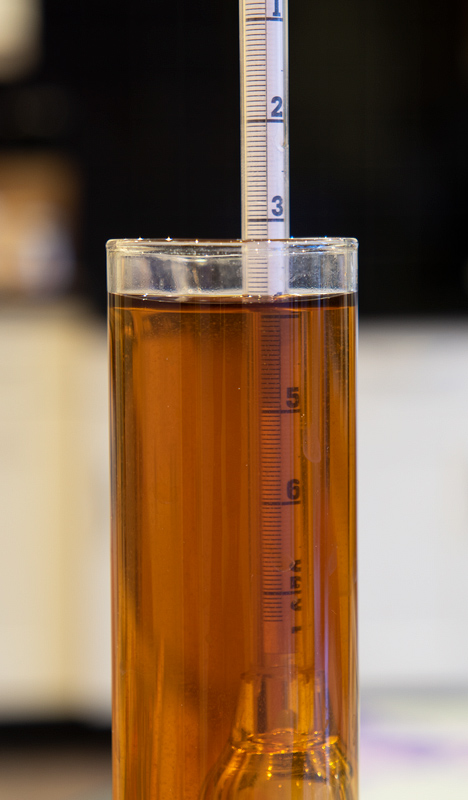
I collected 25 litres into the fermenter, slightly more than predicted and was able to pitch the Brewlab yeast starter straight away at 20C where it will remain for the next 2 weeks.
The huge krausen on the starter had settled back by Friday morning leaving a bit of a yeasty mess under the foil cap. I decanted off 500ml for next time and left the remainder in-place to chill ready for today.
Here's the recipe.
Code:
Recipe Specifications
--------------------------
Date: 5 February 2022
Batch Size (fermenter): 24.00 L
Estimated OG: 1.038 SG
Estimated Color: 24.5 EBC
Estimated IBU: 30 IBUs
Brewhouse Efficiency: 75.00 %
Est Mash Efficiency: 75.6 %
Boil Time: 60 Minutes
Water profile: Ca:78 Mg:3 Na:9 SO4:122 Cl:50
Ingredients:
------------
Amt Name Type %/IBU
28.86 L Tesco Ashbeck Water -
4.80 g Gypsum (Calcium Sulfate) (Mash) Water Agent -
1.40 g Calcium Chloride (Mash) Water Agent -
3.123 kg Crisp Maris Otter (7.9 EBC) Grain 83.9 %
0.276 kg Crisp Medium Crystal (240.0 EBC) Grain 7.4 %
0.030 kg Weyermann Carafa II (1150.0 EBC) Grain 0.8 %
1.00 g Gypsum (Calcium Sulfate) (Sparge) Water Agent -
0.30 g Calcium Chloride (Sparge) Water Agent -
0.295 kg Corn Sugar (Dextrose) [Boil] (0.0 EBC) Sugar 7.9 %
25.00 g Target [8.90 %] - Boil 60.0 min Hop 26.6 IBUs
10.00 g Archer [3.50 %] - Boil 10.0 min Hop 1.5 IBUs
10.00 g Styrian Goldings [4.00 %] - Boil 10.0 min Hop 1.7 IBUs
1.00 Items Whirlfloc Tablet (Boil 7.0 mins) Fining -
1.0 pkg Brewlab Yorkshire (Brewlab #Yorkshire) Yeast -
Mash Schedule: Single Infusion, Full Body, Batch Sparge
Total Grain Weight: 3.724 kg
----------------------------
Name Description Step Temperat Step Time
Mash In Add 23.86 L of water at 73.7 C 69.0 C 60 minThe 10g addition of Archer hops at 10 minutes is mine. I decided that since I was using the darker crystal 240 then it would help to balance out the flavours. As it turned out I had less of the Styrian Goldings left than I thought and had to substitute some Saaz. So at the end of the day my 10 minute additions turned into 10g Archer, 4g Styrian Goldings and 6g Saaz. I'm sure it'll be fine.
I've come to expect the Brewlab Yorkshire yeast to attenuate really strongly if I mash at the 'usual' 65-67C range so I'm doing what I did with the dark mild and mashing at 69C in an attempt to reign it in a bit.
The dextrose was added during the boil and should serve to lighten the body a bit making this nice and quaffable. In my system 75g of sugar equals 1 extra gravity point so I'm getting about 4 points from the 295g in this recipe.
It was a nice and simple brewday and I was all done with the yeast pitched before midday. The OG was spot on at 1.038 and the colour is a nice and pale copper.

I collected 25 litres into the fermenter, slightly more than predicted and was able to pitch the Brewlab yeast starter straight away at 20C where it will remain for the next 2 weeks.
Just realised the brew I did today is really very similar to yours!
Hops are different, but the malt, crystal and carafa are simillar
Hops are different, but the malt, crystal and carafa are simillar
Similar threads
- Replies
- 4
- Views
- 574



